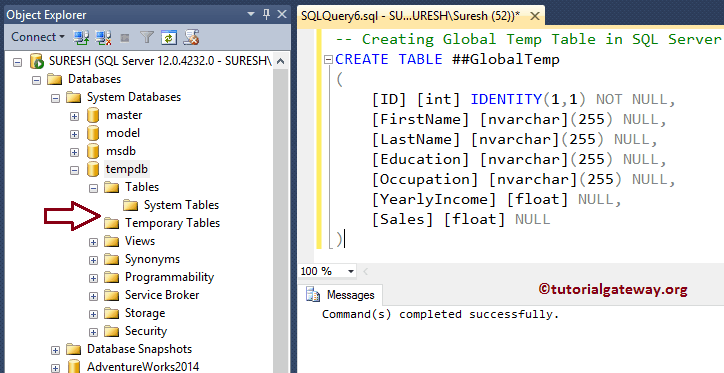What Is Temp Table In Sql Server - Temp tables or temporary tables are a common feature in SQL Server that allow you to store data temporarily. They are essentially tables that are created and destroyed within the context of a session or a transaction. While you can use temporary tables in SQL Server for a variety of purposes, they are particularly useful for storing intermediate results, working with large datasets, sharing data between procedures, and performing complex queries.
How To Create Temp Table In SQL Server
Creating Local Temp Table
To create a local temporary table in SQL Server, you can use the CREATE TABLE statement followed by the # symbol and the table name. Here's an example:

Once you have created the temporary table, you can insert data into it using the INSERT INTO statement, just like you would with a regular table. Here's an example:

When you are done working with the temporary table, you can drop it using the DROP TABLE statement, just like you would with a regular table.
Creating Global Temp Table
In addition to local temporary tables, SQL Server also allows you to create global temporary tables that can be accessed by multiple sessions or transactions. To create a global temporary table, you can use the CREATE TABLE statement followed by the ## symbol and the table name. Here's an example:

Like local temporary tables, you can insert data into a global temporary table using the INSERT INTO statement and drop it using the DROP TABLE statement.
Tips and Ideas for Using Temp Tables in SQL Server
Tip #1: Use Temp Tables for Complex Queries
If you are working with a large dataset or performing a complex query that involves multiple steps, using a temporary table can help simplify your code and improve performance. By breaking down your query into smaller, more manageable steps, you can reduce the amount of data that needs to be processed at each stage, which can lead to faster execution times.
Tip #2: Optimize Your Queries with Indexes
To further improve performance, you can create indexes on your temporary tables to speed up query execution. Just like with regular tables, indexes can help SQL Server quickly locate the data it needs, reducing the amount of time it takes to process your queries.
Idea #1: Store Intermediate Results in Temp Tables
If you are performing a series of calculations or transformations on a dataset, you can use a temporary table to store intermediate results. This can help make your code more modular and easier to maintain, as well as improve performance by reducing the amount of data that needs to be reprocessed at each step.
Idea #2: Share Data Between Stored Procedures
If you have multiple stored procedures that need to work with the same data, you can use a temporary table to share that data between them. By storing the data in a temporary table, you can avoid the need to pass it back and forth between procedures, which can simplify your code and improve performance.
Conclusion
Temp tables are a powerful feature in SQL Server that allow you to store data temporarily and perform complex queries efficiently. Whether you are working with large datasets, sharing data between procedures, or storing intermediate results, using temporary tables can help simplify your code and improve performance. To get started, simply follow the steps outlined in this post and experiment with using temp tables in your own SQL Server projects.
Find more articles about What Is Temp Table In Sql Server